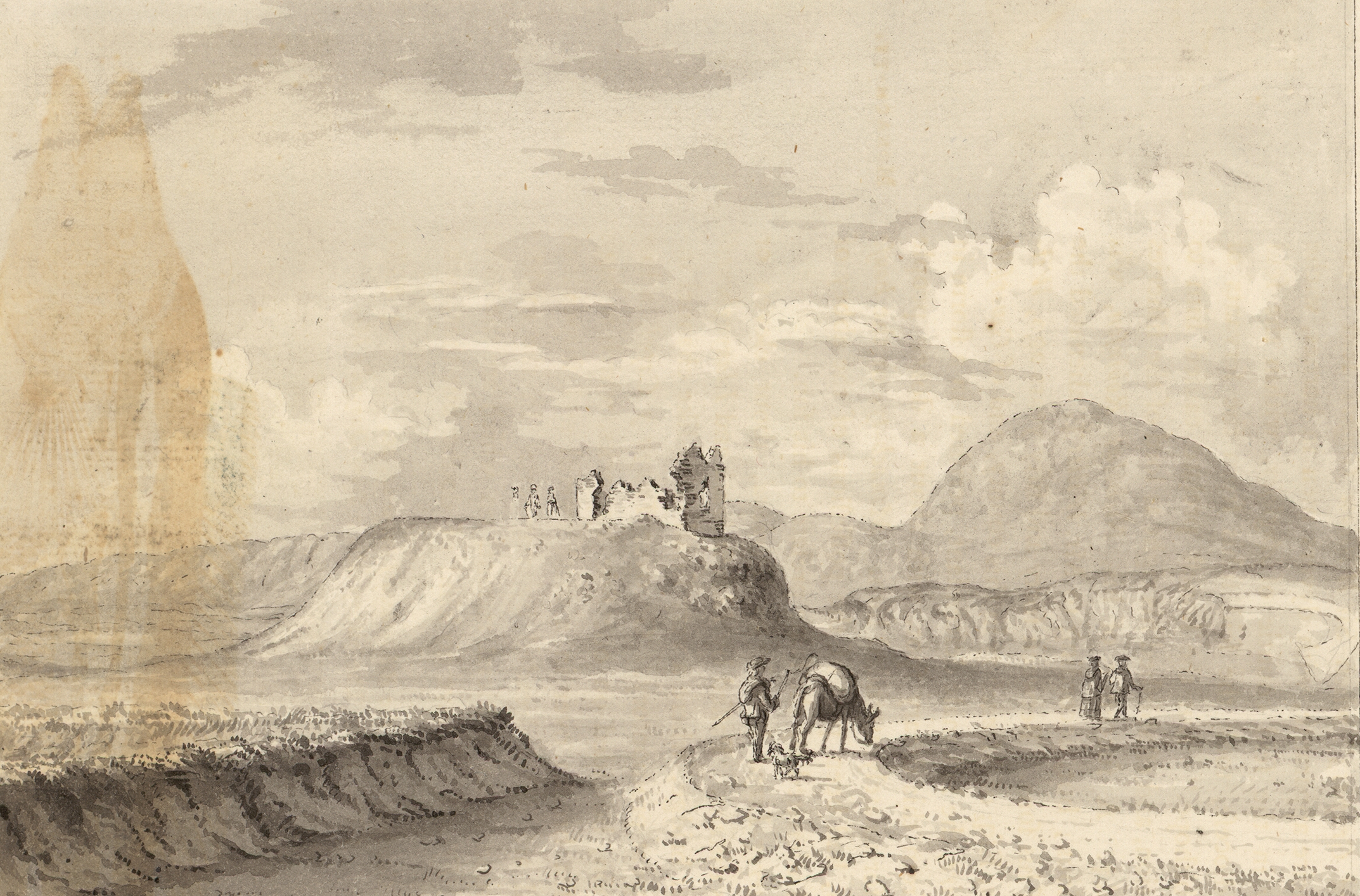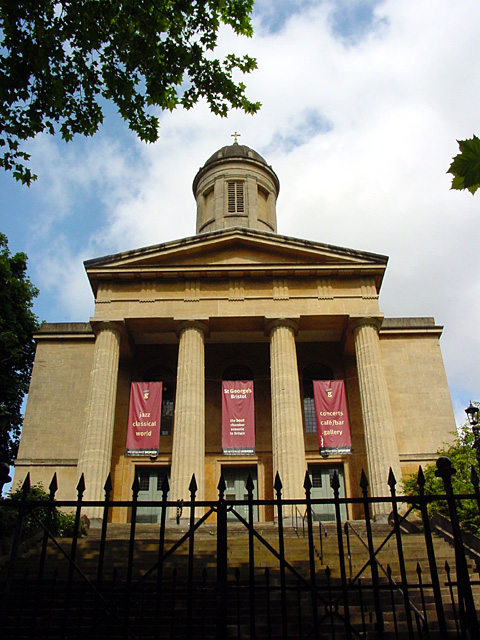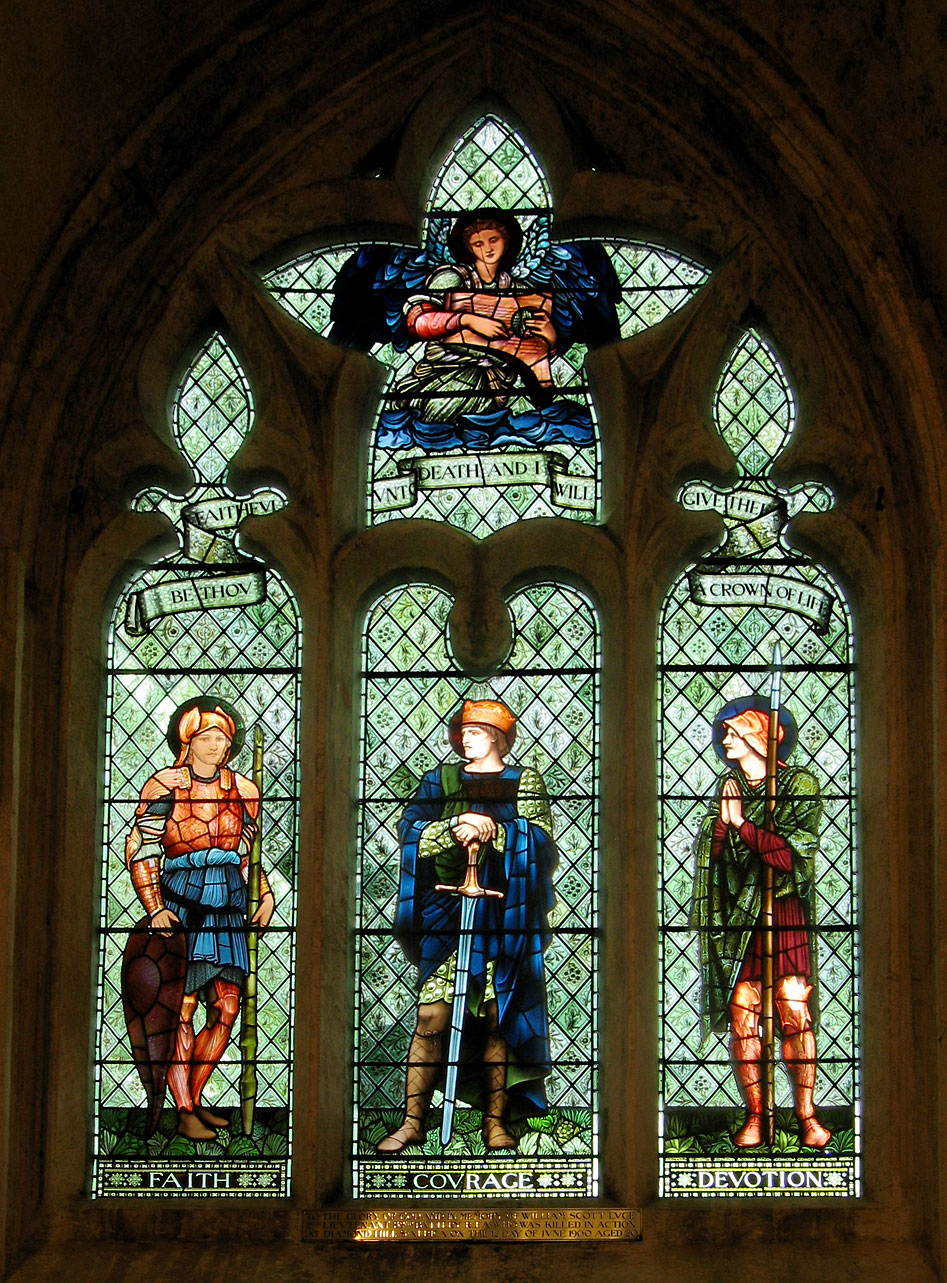|
Church Of The Holy Trinity, Frome
The Frome Holy Trinity in Frome, Somerset, England was built in 1837. It is a Grade II* listed building. History The church was built in 1837, by Henry Goodridge, as a Commissioners' church in a Gothic revival style. Emma Sheppard, workhouse reformer was interred in the churchyard in 1871. In 2015 refurbishment work included new underfloor heating along with improved lighting and audio visual capabilities. The parish and benefice of Frome (Holy Trinity) are within the Diocese of Bath and Wells. Architecture It is a stone building. Nine of the stained glass windows were designed by Edward Burne-Jones. The figures are powerfully drawn, with vibrant colours and leafy backgrounds. They were made and installed by Morris & Co., between 1880 and 1918. A pamphlet available in the church has illustrations of all the windows with details of each commission. The only stained glass windows which were not designed by Burne-Jones are placed above the altar and were made and instal ... [...More Info...] [...Related Items...] OR: [Wikipedia] [Google] [Baidu] |
Frome
Frome ( ) is a town and civil parish in eastern Somerset, England. The town is built on uneven high ground at the eastern end of the Mendip Hills, and centres on the River Frome. The town, about south of Bath, is the largest in the Mendip district of Somerset and is part of the parliamentary constituency of Somerton and Frome. The population was 28,559 in 2021. Frome was one of the largest towns in Somerset until the Industrial Revolution, and was larger than Bath from AD 950 until 1650. The town first grew due to the wool and cloth industry; it later diversified into metal-working and printing, although these have declined. The town was enlarged during the 20th century but retains a large number of listed buildings, and most of the centre falls within a conservation area. In the 2011 census, the population was given as 26,203. The town has road and rail transport links and acts as an economic centre for the surrounding area. It provides a centre for cultural and sportin ... [...More Info...] [...Related Items...] OR: [Wikipedia] [Google] [Baidu] |
Somerset
( en, All The People of Somerset) , locator_map = , coordinates = , region = South West England , established_date = Ancient , established_by = , preceded_by = , origin = , lord_lieutenant_office =Lord Lieutenant of Somerset , lord_lieutenant_name = Mohammed Saddiq , high_sheriff_office =High Sheriff of Somerset , high_sheriff_name = Mrs Mary-Clare Rodwell (2020–21) , area_total_km2 = 4171 , area_total_rank = 7th , ethnicity = 98.5% White , county_council = , unitary_council = , government = , joint_committees = , admin_hq = Taunton , area_council_km2 = 3451 , area_council_rank = 10th , iso_code = GB-SOM , ons_code = 40 , gss_code = , nuts_code = UKK23 , districts_map = , districts_list = County council area: , MPs = * Rebecca Pow (C) * Wera Hobhouse ( LD) * Liam Fox (C) * David Warburton (C) * Marcus Fysh (C) * Ian Liddell-Grainger (C) * James Heappey (C) * Jacob Rees-Mogg (C) * John Penrose (C) , police = Avon and Somerset Police ... [...More Info...] [...Related Items...] OR: [Wikipedia] [Google] [Baidu] |
Listed Building
In the United Kingdom, a listed building or listed structure is one that has been placed on one of the four statutory lists maintained by Historic England in England, Historic Environment Scotland in Scotland, in Wales, and the Northern Ireland Environment Agency in Northern Ireland. The term has also been used in the Republic of Ireland, where buildings are protected under the Planning and Development Act 2000. The statutory term in Ireland is " protected structure". A listed building may not be demolished, extended, or altered without special permission from the local planning authority, which typically consults the relevant central government agency, particularly for significant alterations to the more notable listed buildings. In England and Wales, a national amenity society must be notified of any work to a listed building which involves any element of demolition. Exemption from secular listed building control is provided for some buildings in current use for worship, ... [...More Info...] [...Related Items...] OR: [Wikipedia] [Google] [Baidu] |
Henry Goodridge
Henry Edmund Goodridge (1797, Bath – 26 October 1864) was an English architect based in Bath. He worked from the early 1820s until the 1850s, using Classical, Italianate and Gothic styles. Life He was born in Bath in 1797 the son of James Goodridge, who was at that time was engaged in large speculative building projects in connection with the management of the estate of Sir William Pulteney, at Bathwick. On the advice of Thomas Telford, his father had him articled to John Lowder, then the City Architect for Bath. Having set up his own practice, his early work consisted mostly of alterations, laying out blocks for building, and designing villas. He converted the Old Orchard Street Theatre into a Catholic church. His first important work was the enlargement of the Roman Catholic Downside College, (1821-3) near Bath, parts of which were praised by Pugin. His work there included the vaulted Gothic chapel, which was originally heavily pinnacled. In 1824 he built Christ Church a ... [...More Info...] [...Related Items...] OR: [Wikipedia] [Google] [Baidu] |
Commissioners' Church
A Commissioners' church, also known as a Waterloo church and Million Act church, is an Anglican church in the United Kingdom built with money voted by Parliament as a result of the Church Building Acts of 1818 and 1824. The 1818 Act supplied a grant of money and established the Church Building Commission to direct its use, and in 1824 made a further grant of money. In addition to paying for the building of churches, the Commission had powers to divide and subdivide parishes, and to provide endowments. The Commission continued to function as a separate body until the end of 1856, when it was absorbed into the Ecclesiastical Commission. In some cases the Commissioners provided the full cost of the new church; in other cases they provided a partial grant and the balance was raised locally. In total 612 new churches were provided, mainly in expanding industrial towns and cities. Title The First Parliamentary Grant for churches amounted to £1 million (equivalent to £ in ), ... [...More Info...] [...Related Items...] OR: [Wikipedia] [Google] [Baidu] |
Gothic Revival Architecture
Gothic Revival (also referred to as Victorian Gothic, neo-Gothic, or Gothick) is an architectural movement that began in the late 1740s in England. The movement gained momentum and expanded in the first half of the 19th century, as increasingly serious and learned admirers of the neo-Gothic styles sought to revive medieval Gothic architecture, intending to complement or even supersede the neoclassical styles prevalent at the time. Gothic Revival draws upon features of medieval examples, including decorative patterns, finials, lancet windows, and hood moulds. By the middle of the 19th century, Gothic had become the preeminent architectural style in the Western world, only to fall out of fashion in the 1880s and early 1890s. The Gothic Revival movement's roots are intertwined with philosophical movements associated with Catholicism and a re-awakening of high church or Anglo-Catholic belief concerned by the growth of religious nonconformism. Ultimately, the "Anglo-Catholicism" t ... [...More Info...] [...Related Items...] OR: [Wikipedia] [Google] [Baidu] |
Emma Sheppard
Emma Sheppard (1813–1871) was an English writer and workhouse reformer in Frome, who became widely known for her book ''Sunshine in the Workhouse'' and for efforts, both local and national, to improve conditions for inmates. Early life Emma Brown from Bath married George Wood Sheppard (1807-1894), the second son of Sheppard family (clothiers)#George Sheppard (1773-1855) captain of industry, George Sheppard, in 1834; they had a daughter, Mary Stuart in 1841. They first lived in Berkley House. In 1848, by which time she had had seven children, they moved into Fromefield House with George Sheppard senior, some ten years after the death of his wife, Mary Ann Stuart Byard. Emma's husband was a pillar of local society: a Justice of the peace, JP, chair of the Board of Guardians which ran the workhouse as part of the Poor Law Amendment Act 1834, vice-president of the Frome Literary and Scientific Institution (now the Frome Museum), trustee of Frome charities, supporter of the F ... [...More Info...] [...Related Items...] OR: [Wikipedia] [Google] [Baidu] |
Benefice
A benefice () or living is a reward received in exchange for services rendered and as a retainer for future services. The Roman Empire used the Latin term as a benefit to an individual from the Empire for services rendered. Its use was adopted by the Western Church in the Carolingian, Carolingian Era as a benefit bestowed by the crown or church officials. A benefice specifically from a church is called a precaria (pl. ''precariae)'', such as a stipend, and one from a monarch or nobleman is usually called a fief. A benefice is distinct from an allodial title, allod, in that an allod is property owned outright, not bestowed by a higher authority. Roman Catholic Church Roman imperial origins In ancient Rome a ''benefice'' was a gift of land (precaria) for life as a reward for services rendered, originally, to the state. The word comes from the Latin language, Latin noun ''beneficium'', meaning "benefit". Carolingian Era In the 8th century, using their position as Mayor of the Pa ... [...More Info...] [...Related Items...] OR: [Wikipedia] [Google] [Baidu] |
Diocese Of Bath And Wells
The Diocese of Bath and Wells is a diocese in the Church of England Province of Canterbury in England. The diocese covers the county of Somerset and a small area of Dorset. The Episcopal seat of the Bishop of Bath and Wells is located in the Cathedral Church of Saint Andrew in the city of Wells in Somerset. History Early name variation Before 909, Somerset lay within the diocese of Sherborne. At this date, Athelm (later Archbishop of Canterbury) was appointed the first bishop of the Diocese of Wells, making the secular church there into the diocesan cathedral. The secular canons at Wells vied with the monks of the monasteries at Glastonbury and Bath for supremacy in the diocese and it was with difficulty that the cathedral retained its status, so much so that the canons were reduced to begging in order to obtain their bread. It was to this impoverished cathedral church that Gisa was appointed bishop in 1060. Under him, grants of land were obtained successively from the kings ... [...More Info...] [...Related Items...] OR: [Wikipedia] [Google] [Baidu] |
Stained Glass
Stained glass is coloured glass as a material or works created from it. Throughout its thousand-year history, the term has been applied almost exclusively to the windows of churches and other significant religious buildings. Although traditionally made in flat panels and used as windows, the creations of modern stained glass artists also include three-dimensional structures and sculpture. Modern vernacular usage has often extended the term "stained glass" to include domestic lead light and ''objets d'art'' created from foil glasswork exemplified in the famous lamps of Louis Comfort Tiffany. As a material ''stained glass'' is glass that has been coloured by adding metallic salts during its manufacture, and usually then further decorating it in various ways. The coloured glass is crafted into ''stained glass windows'' in which small pieces of glass are arranged to form patterns or pictures, held together (traditionally) by strips of lead and supported by a rigid frame. Painte ... [...More Info...] [...Related Items...] OR: [Wikipedia] [Google] [Baidu] |
Edward Burne-Jones
Sir Edward Coley Burne-Jones, 1st Baronet, (; 28 August, 183317 June, 1898) was a British painter and designer associated with the Pre-Raphaelite Brotherhood which included Dante Gabriel Rossetti, John Millais, Ford Madox Brown and Holman Hunt. Burne-Jones worked with William Morris as a founding partner in Morris, Marshall, Faulkner & Co in the design of decorative arts. Burne-Jones's early paintings show the influence of Dante Gabriel Rossetti, but by 1870 he had developed his own style. In 1877, he exhibited eight oil paintings at the Grosvenor Gallery (a new rival to the Royal Academy). These included ''The Beguiling of Merlin''. The timing was right and Burne-Jones was taken up as a herald and star of the new Aesthetic Movement. In the studio of Morris and Co. Burne-Jones worked as a designer of a wide range of crafts including ceramic tiles, jewellery, tapestries, and mosaics. Among his most significant and lasting designs are those for stained glass windows the pr ... [...More Info...] [...Related Items...] OR: [Wikipedia] [Google] [Baidu] |
Morris & Co
Morris, Marshall, Faulkner & Co. (1861–1875) was a furnishings and decorative arts manufacturer and retailer founded by the artist and designer William Morris with friends from the Pre-Raphaelites. With its successor Morris & Co. (1875–1940) the firm's medieval-inspired aesthetic and respect for hand-craftsmanship and traditional textile arts had a profound influence on the decoration of churches and houses into the early 20th century. Although its most influential period was during the flourishing of the Arts and Crafts Movement in the 1880s and 1890s, Morris & Co. remained in operation in a limited fashion from World War I until its closure in 1940. The firm's designs are still sold today under licences given to Sanderson & Sons, part of the Walker Greenbank wallpaper and fabrics business (which owns the "Morris & Co." brand,) and to Liberty of London. Early years Morris, Marshall, Faulkner & Co., "Fine Art Workmen in Painting, Carving, Furniture and the Metals", w ... [...More Info...] [...Related Items...] OR: [Wikipedia] [Google] [Baidu] |









